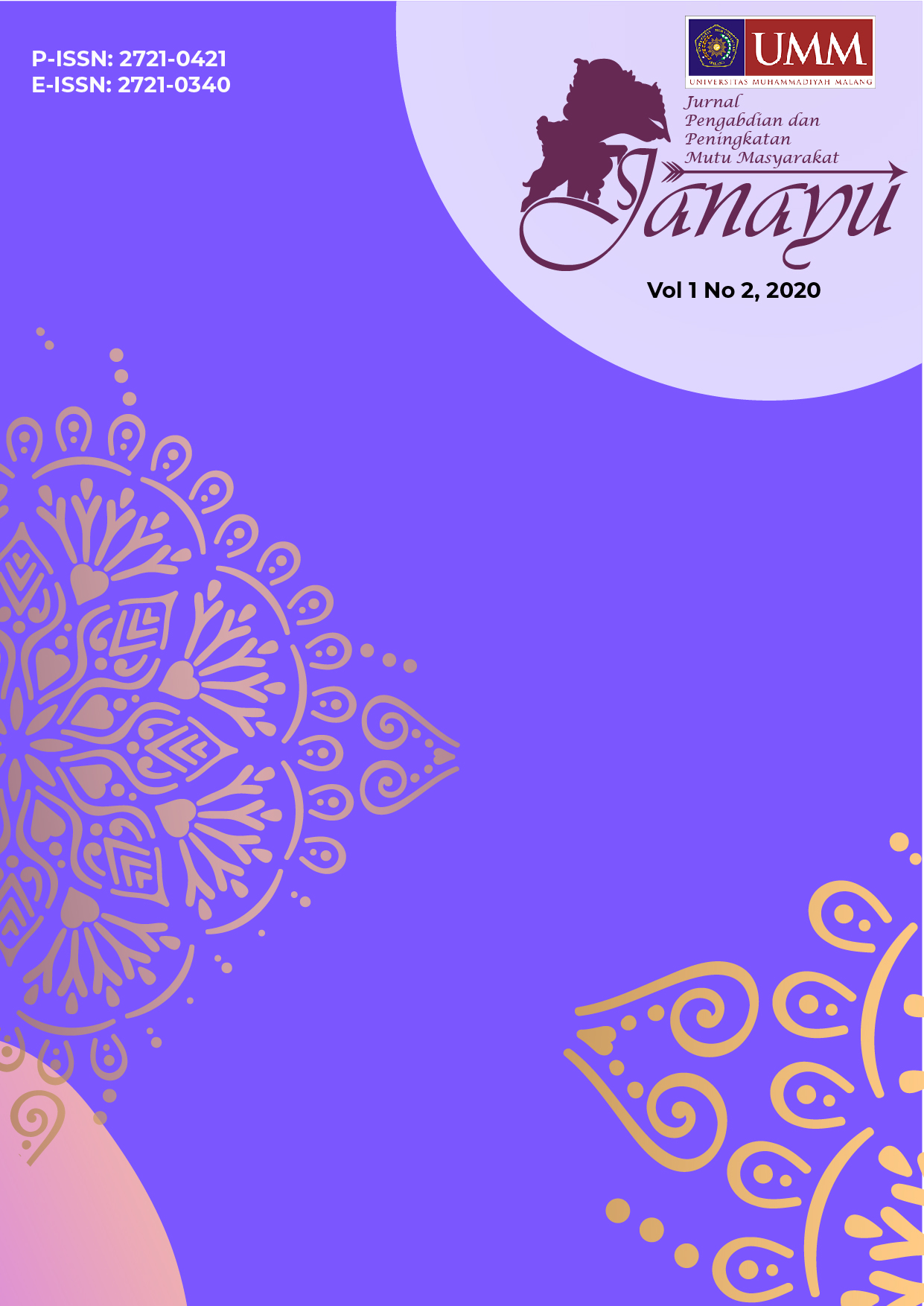PENINGKATAN AKSES AIR BERSIH MELALUI SOSIALISASI DAN PENYARINGAN AIR SEDERHANA DESA HAURPUGUR
DOI:
https://doi.org/10.22219/janayu.v1i2.11784Keywords:
Clean Water, Socialization, Simple FilterAbstract
The use of clean water is one of the tagsets of Clean and Healthy Life Behavior (PHBS) for Households. Data from the Central Statistics Agency (BPS) states that the achievement of access to safe water in Indonesia has only reached 72.55%, below the Sustainable Development Goals (SDGs) target of 100%. Water for Hygiene Purposes Sanitation is water of a certain quality that is used for daily needs whose quality is different from the quality of
drinking water. Haurpugur villagers use water that does not meet health requirements. Water in Haurpugur village tends to contain iron. Some of the water sources are dug wells. Where dug wells with an average depth of wells range from 10-15 meters. At these depths, the Fe and Mn contents settle to the bottom of the well. Most (55.8%) residents know well about the use of clean water. However, due to economic limitations, the fulfillment of clean
water needs is ignored. In an effort to increase the knowledge of citizens and at the same time increase the coverage of clean water, it is necessary to carry out community service through socialization about clean water and making a simple filter of clean water. Achieving the fulfillment of clean water is a disease prevention limit that results from not fulfilling basic sanitation such as diarrhea.
Downloads
References
Alihar, F. (2018) ‘Penduduk Dan Akses Air Bersih Di Kota Semarang (Population And Access To Clean Water In Semarang City)’, Jurnal Kependudukan Indonesia, Vol. 13 No(Juni 2018), pp. 67–76.
Indonesia.Go.Id (2019) Air Bersih : Mengejar Pencapaian Akses 100% di 2019, https://indonesia.go.id/narasi/indonesia-dalam-angka/ekonomi/mengejar-pencapaian-akses-100-di-2019. Available at: https://indonesia.go.id/narasi/indonesia-dalam-angka/ekonomi/mengejar-pencapaian-akses-100-di-2019.
Kemenkes, R. (1990) Daftar Persyaratan Kualitas Air. Peraturan Menteri Kesehatan Republik Indonesia. Nomor : 416/MENKES/PER/IX/1990 Tanggal : 3 September 1990.
Kemenkes, R. (2017) Peraturan Menteri Kesehatan Republik Indonesia Nomor 32 Tahun 2017 Tentang Standar Baku Mutu Kesehatan Lingkungan Dan Persyaratan Kesehatan Air Untuk.
Kemenkes, R. (2019) Peraturan Menteri Kesehatan Republik Indonesia Nomor 8 Tahun 2019 Tentang Pemberdayaan Masyarakat Bidang Kesehatan.
Notoatmodjo, S. (2014) Ilmu Perilaku Kesehatan. Jakarta: Rineka Cipta.
Perpamsi (2018) Selamat Hari Air Dunia 2018. Available at: https://perpamsi.or.id/berita/view/2018/03/22/468/selamat-hari-air-dunia-2018.
Prihatin, R. B. dkk (2015) Penyediaan Air Bersih Di Indonesia: Peran Pemerintah, Pemerintah Daerah, Swasta, Dan Masyarakat. Edited by S. N. Qodriyatun. Jakarta: P3DI Setjen DPR RI dan Azza Grafika. Available at: http://berkas.dpr.go.id/puslit/files/buku_tim/buku-tim-public-42.pdf.
Raksanagara, A. S. (2017) ‘Faktor yang Memengaruhi Perilaku Penggunaan Air Bersih pada Masyarakat Kumuh Perkotaan’, MKB, 49 NO: 2(Juni 2017).
Sekretariat Kabinet, R. (2017) Lampiran Peraturan Presiden Republik Indonesia Nomor 59 Tahun 2017 tentang Pelaksanaan Pencapaian Tujuan Pembangunan Berkelanjutan. Available at: http://setkab.go.id/category/peraturan.
Sukartini, N. M. (2016) ‘Akses Air Bersih di Indonesia’, JURNAL EKONOMI KUANTITATIF TERAPAN, Vol. 9 No.(AGUSTUS 2016).
WHO (2018) WHO: Watern Sanitation and Higiene 2018-2025. Switzerland. WHO (2019) WHO Global Water, Sanitation And Hygiene : annual Report 2018. Available at: https://apps.who.int/iris/bitstream/handle/10665/327118/WHO-CED-PHE-WSH-19.147-eng.pdf?ua=1.
WHO (2020) Water safety and quality. Available at: https://www.who.int/water_sanitation_health/water-quality/en/.
Downloads
Published
How to Cite
Issue
Section
License
Copyright (c) 2020 RATNA DIAN KURNIAWATI

This work is licensed under a Creative Commons Attribution-ShareAlike 4.0 International License.

















